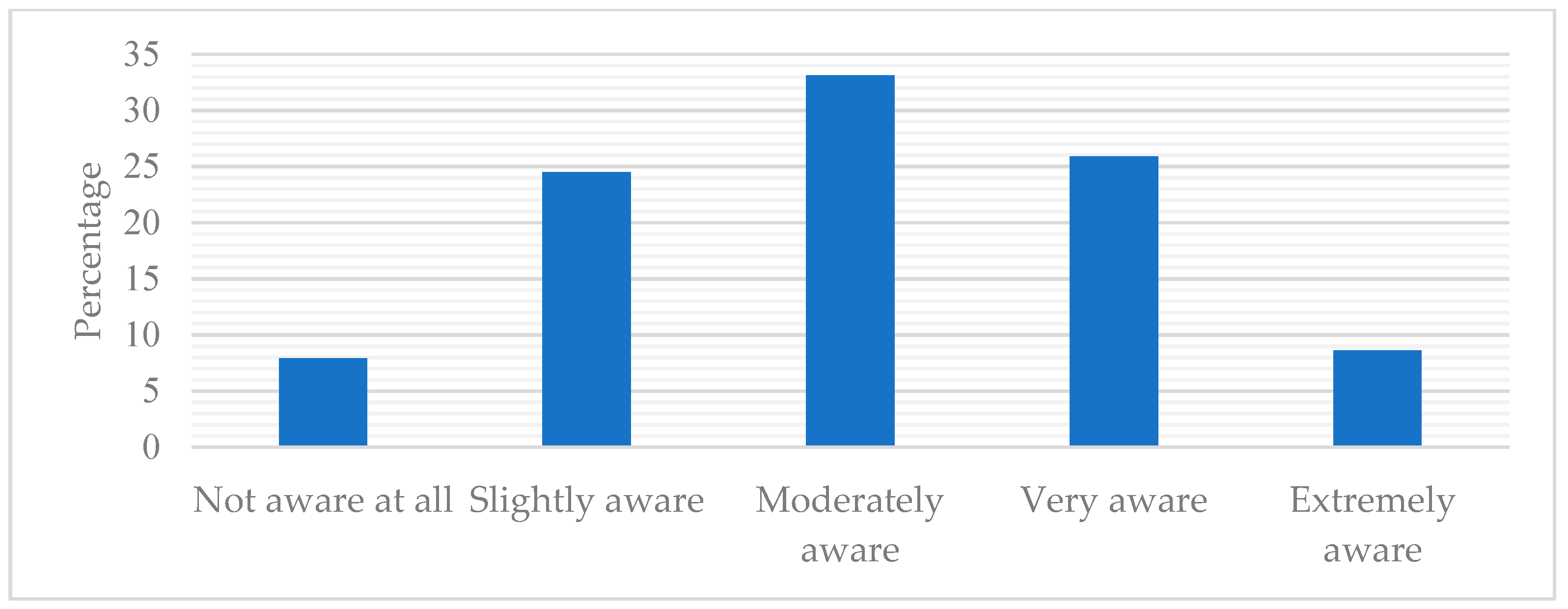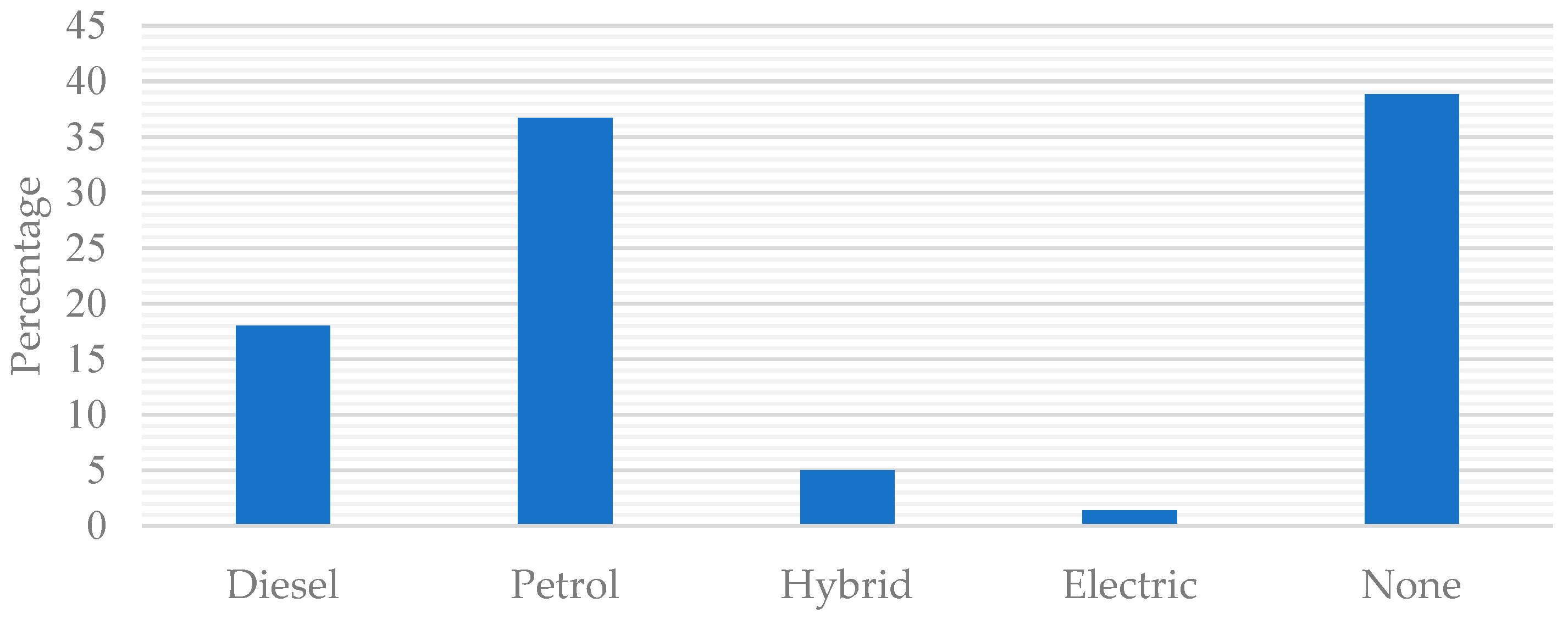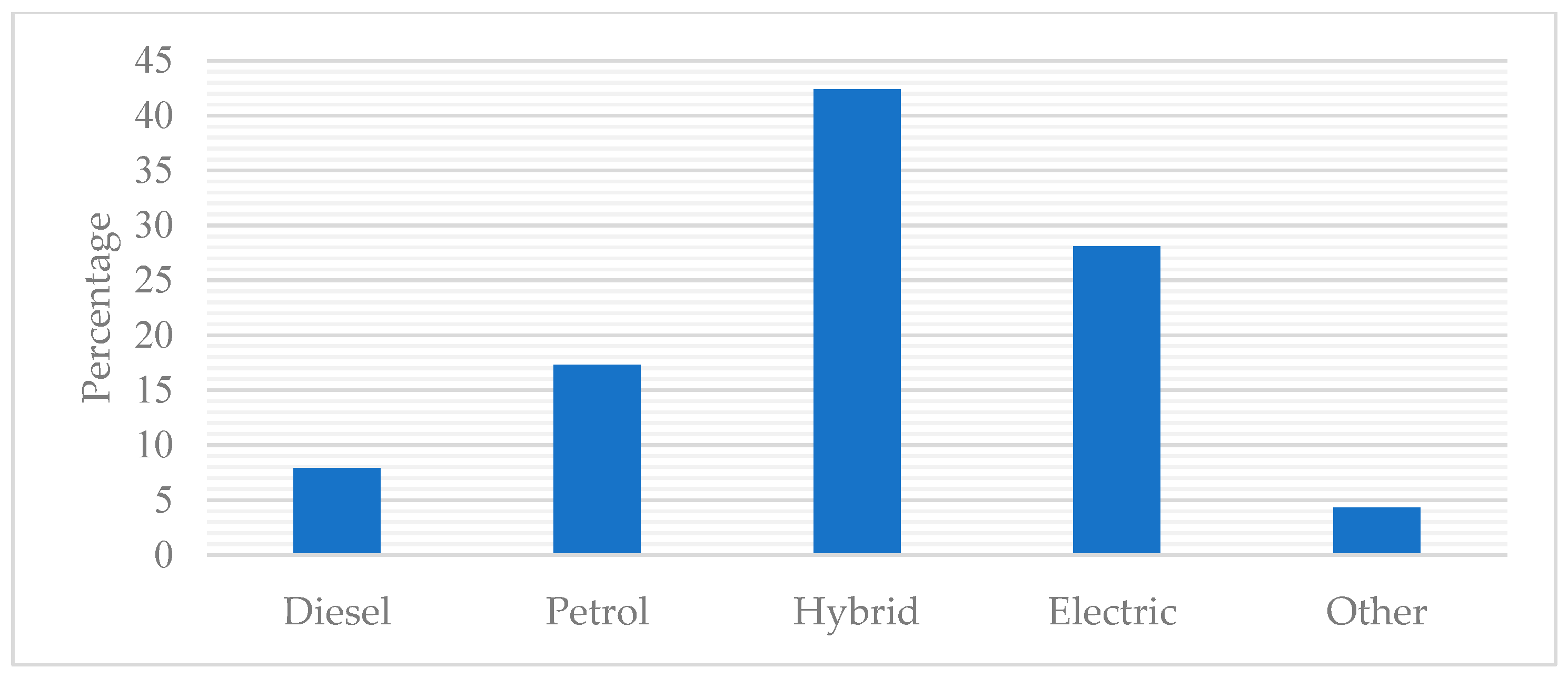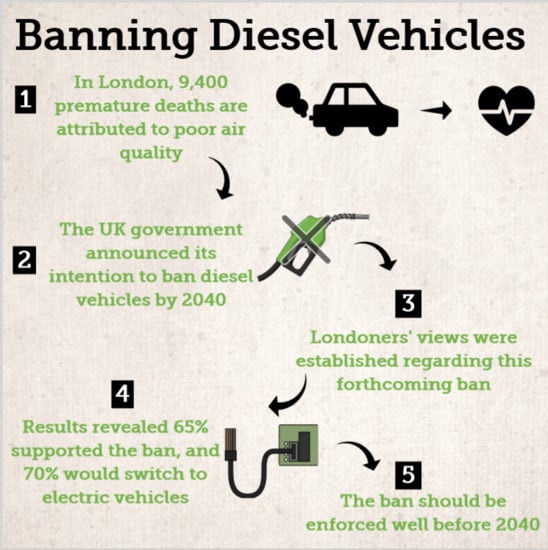Banning Diesel Vehicles in London: Is 2040 Too Late?
Abstract
1. Introduction
2. Case Study, Data and Methods
2.1. Case Study Context
2.2. Data and Methods
- ○
- N: Total sample size
- ○
- K: Number of samples
- ○
- Ri: Sum of ranks in the ith sample
- ○
- ni: Size of the ith sample.
3. Results and Discussion
3.1. Air Quality Satisfaction
3.2. Awareness Level of Diesel Vehicle Emissions
3.3. Information Provision
3.4. Banning Diesel Vehicles
3.5. Type of Vehicle Owned by Participants
3.6. Shifting to Electric Vehicles
3.7. Influence on which Kind of Vehicle to Purchase
4. Conclusions and Policy Implications
Author Contributions
Funding
Acknowledgments
Conflicts of Interest
Abbreviations and Acronyms
| CO2 | Carbon Dioxide |
| NOx | Nitrogen Oxides |
| PM | Particulate Matter |
| GHG | Greenhouse Gas |
| MTS | Mayor’s Transport Strategy |
| LEZs | Low Emission Zones |
| EVs | Electric Vehicles |
| ICE | Internal Combustion Engine |
| N | Total Sample Size |
| K | Number of Samples |
| Ri | Sum of Ranks in the ith Sample |
| ni | Size of the ith Sample |
| KWT | Kruskal–Wallis Test |
| CNG | Compressed Natural Gas |
| SO2 | Sulphur Dioxide |
| CO | Carbon Monoxide |
| DALYs | Disability Adjusted Life Years |
References
- European Commission. Commission and ACEA Agree on CO2 Emissions from Cars. Available online: http://europa.eu/rapid/press-release_IP-98-734_en.htm?locale=en (accessed on 16 July 2019).
- Laybourn-Langton, L.; Quilter-Pinner, H.; Ho, H. Lethal and Illegal: London’s Air Pollution Crisis; Institute for Public Policy Research: London, UK, 2016; Available online: https://www.ippr.org/research/publications/lethal-and-illegal-londons-air-pollution-crisis (accessed on 26 July 2019).
- Department for Transport. Transport Statistics Great Britain 2017; Department for Transport: London, UK, 2017. Available online: https://www.gov.uk/government/statistics/transport-statistics-great-britain-2017 (accessed on 16 July 2019).
- Turcksin, L.; Mairesse, O.; Macharis, C.; Mierlo, J.V. Encouraging environmentally friendlier cars via fiscal measures: General methodology and application to Belgium. Energies 2013, 6, 471–491. [Google Scholar] [CrossRef]
- Sullivan, J.L.; Baker, R.E.; Boyer, B.A.; Hammerle, R.H.; Kenney, T.E.; Muniz, L.; Wallington, T.J. CO2 emission benefit of diesel (versus Gasoline) powered vehicles. Environ. Sci. Technol. 2004, 38, 3217–3223. [Google Scholar] [CrossRef] [PubMed]
- Helmers, E.; Leitão, J.; Tietge, U.; Butler, T. CO2-equivalent emissions from European passenger vehicles in the years 1995–2015 based on real-world use: Assessing the climate benefit of the European “diesel boom”. Atmos. Environ. 2019, 198, 122–132. [Google Scholar] [CrossRef]
- Dey, S.; Caulfield, B.; Ghosh, B. Potential health and economic benefits of banning diesel traffic in Dublin, Ireland. J. Transp. Health 2018, 10, 156–166. [Google Scholar] [CrossRef]
- Andrés, L.; Padilla, E. Driving factors of GHG emissions in the EU transport activity. Transp. Policy 2018, 61, 60–74. [Google Scholar] [CrossRef]
- Seo, J.; Park, J.; Oh, Y.; Park, S. Estimation of total transport CO2 emissions generated by medium-and heavy-duty vehicles (MHDVs) in a sector of Korea. Energies 2016, 9, 638. [Google Scholar] [CrossRef]
- Santos, G. Road transport and CO2 emissions: What are the challenges? Transp. Policy 2017, 59, 71–74. [Google Scholar] [CrossRef]
- Vallack, H.; Haq, G.; Whitelegg, J.; Cambridge, H. Policy pathways towards achieving a zero-carbon transport sector in the UK in 2050. World Transp. Policy Pract. 2014, 20, 28–42. [Google Scholar]
- Keuken, M.P.; Moerman, M.; Voogt, M.; Blom, M.; Weijers, E.P.; Röckmann, T.; Dusek, U. Source contributions to PM2.5 and PM10 at an urban background and a street location. Atmos. Environ. 2013, 71, 26–35. [Google Scholar] [CrossRef]
- Greater London Authority. Comparison of Air Quality in London with a Number of World and European Cities; Greater London Authority: London, UK, 2014. Available online: https://www.london.gov.uk/sites/default/files/comparison_of_air_quality_in_world_cities_study_final.pdf (accessed on 16 July 2019).
- European Commission. Air Quality: Commission Sends Final Warning to the UK Over Levels of Fine Particle Pollution; European Commission: Brussels, Belgium, 2010; Available online: https://europa.eu/rapid/press-release_IP-10-687_en.htm (accessed on 15 July 2019).
- Brand, C. Beyond ‘Dieselgate’: Implications of unaccounted and future air pollutant emissions and energy use for cars in the United Kingdom. Energy Policy 2016, 97, 1–12. [Google Scholar] [CrossRef]
- London Councils. 2018 Air Quality Polling. Available online: https://www.londoncouncils.gov.uk/our-key-themes/environment/air-quality-london/air-quality-public-polling/2018-air-quality-polling (accessed on 26 August 2019).
- Greater London Authority. The Mayor’s Transport Strategy; Greater London Authority: London, UK, 2018. Available online: https://www.london.gov.uk/what-we-do/transport/our-vision-transport/mayors-transport-strategy-2018 (accessed on 16 July 2019).
- The UK Government’s Approach to Delivering the Global Goals for Sustainable Development—At Home and Around the World. Available online: https://assets.publishing.service.gov.uk/government/uploads/system/uploads/attachment_data/file/603500/Agenda-2030-Report4.pdf (accessed on 12 August 2019).
- UK Plan for Tackling Roadside Nitrogen Dioxide Concentrations: An Overview. Available online: https://assets.publishing.service.gov.uk/government/uploads/system/uploads/attachment_data/file/633269/air-quality-plan-overview.pdf (accessed on 16 July 2019).
- Bennett, R.; Vijaygopal, R. An assessment of UK drivers’ attitudes regarding the forthcoming ban on the sale of petrol and diesel vehicles. Transp. Res. Part D Transp. Environ. 2018, 62, 330–344. [Google Scholar] [CrossRef]
- Meyer, D. Germany’s First Diesel Vehicle Ban Has Started in Hamburg. Available online: https://fortune.com/2018/05/31/germany-hamburg-diesel-ban/ (accessed on 16 July 2019).
- Möhner, M. Driving ban for diesel-powered vehicles in major cities: An appropriate penalty for exceeding the limit value for nitrogen dioxide? Int. Arch. Occup Environ. Health 2018, 91, 373–376. [Google Scholar] [CrossRef]
- O’Neill, E.; Moore, D.; Kelleher, L.; Brereton, F. Barriers to electric vehicle uptake in Ireland: Perspectives of car-dealers and policy-makers. Case Stud. Transp. Policy 2019, 7, 118–127. [Google Scholar] [CrossRef]
- Ellison, R.B.; Greaves, S.P.; Hensher, D.A. Five years of London’s low emission zone: Effects on vehicle fleet composition and air quality. Transp. Res. Part D Transp. Environ. 2013, 23, 25–33. [Google Scholar] [CrossRef]
- Ferreira, F.; Gomes, P.; Tente, H.; Carvalho, A.C.; Pereira, P.; Monjardino, J. Air quality improvements following implementation of Lisbon’s Low Emission Zone. Atmos. Environ. 2015, 122, 373–381. [Google Scholar] [CrossRef]
- Fensterer, V.; Küchenhoff, H.; Maier, V.; Wichmann, H.-E.; Breitner, S.; Peters, A.; Gu, J.; Cyrys, J. Evaluation of the Impact of Low Emission Zone and Heavy Traffic Ban in Munich (Germany) on the Reduction of PM10 in Ambient Air. Int. J. Environ. Res. Public Health 2014, 11, 5094–5112. [Google Scholar] [CrossRef] [PubMed]
- Dastgerdi, A.S.; De Luca, G. Strengthening the city’s reputation in the age of cities: An insight in the city branding theory. City Territ. Archit. 2019, 6, 2. [Google Scholar] [CrossRef]
- De Jong, M.; Hoppe, T.; Noori, N. City Branding, Sustainable Urban Development and the Rentier State. How do Qatar, Abu Dhabi and Dubai present Themselves in the Age of Post Oil and Global Warming? Energies 2019, 12, 1657. [Google Scholar] [CrossRef]
- Greater London Authority. A Growing Population. Available online: https://www.london.gov.uk//what-we-do/planning/london-plan/current-london-plan/london-plan-chapter-one-context-and-strategy-0 (accessed on 16 July 2019).
- Font, A.; Guiseppin, L.; Blangiardo, M.; Ghersi, V.; Fuller, G.W. A tale of two cities: Is air pollution improving in Paris and London? Environ. Pollut. 2019, 249, 1–12. [Google Scholar] [CrossRef]
- Statista. Licensed Cars in London, England 1995–2018. Available online: https://www.statista.com/statistics/314980/licensed-cars-in-london-england-united-kingdom/ (accessed on 27 August 2019).
- Walton, H.; Dajnak, D.; Beevers, S.; Williams, M.; Watkiss, P.; Hunt, A. Understanding the Health Impacts of Air Pollution in London. 2015. Available online: https://www.london.gov.uk/WHAT-WE-DO/environment/environment-publications/understanding-health-impacts-air-pollution-london (accessed on 15 July 2019).
- Gordon, I.R.; McCann, P. Innovation, agglomeration, and regional development. J. Econ. Geogr. 2005, 5, 523–543. [Google Scholar] [CrossRef]
- Cao, M.; Hickman, R. Car dependence and housing affordability: An emerging social deprivation issue in London? Urban Stud. 2018, 55, 2088–2105. [Google Scholar] [CrossRef]
- Davies, A.; MacAulay, S.; DeBarro, T.; Thurston, M. Making Innovation Happen in a Megaproject: London’s Crossrail Suburban Railway System. Proj. Manag. J. 2014, 45, 25–37. [Google Scholar] [CrossRef]
- Mindell, J.S.; Cohen, J.M.; Watkins, S.; Tyler, N. Synergies between low-carbon and healthy transport policies. Proc. Inst. Civ. Eng. Transp. 2011, 164, 127–139. [Google Scholar] [CrossRef]
- Quarmby, S.; Santos, G.; Mathias, M. Air Quality Strategies and Technologies: A Rapid Review of the International Evidence. Sustainability 2019, 11, 2757. [Google Scholar] [CrossRef]
- Greater London Authority. London Atmospheric Emissions Inventory (LAEI) 2013—London Datastore. Available online: https://data.london.gov.uk/dataset/london-atmospheric-emissions-inventory-2013 (accessed on 25 July 2019).
- Valliant, R.; Dever, J.A.; Kreuter, F. Basic steps in weighting. In Practical Tools for Designing and Weighting Survey Samples. Statistics for Social and Behavioral Sciences; Springer: London, UK, 2013. [Google Scholar]
- Cao, M. Exploring the Relation between Transport and Social Equity: Empirical Evidence from London and Beijing. Ph.D. Thesis, University College London, London, UK, 2019. [Google Scholar]
- Cao, M.; Hickman, R. Urban transport and social inequities in neighbourhoods near underground stations in Greater London. Transp. Plan. Technol. 2019, 42, 419–441. [Google Scholar] [CrossRef]
- Cao, M.; Robin, H. Transport, social equity and capabilities in East Beijing. In Handbook on Transport and Urban Transformation in Contemporary China; Chen, C., Pan, H., Shen, Q., Wang, J., Eds.; Edward Elgar: London, UK, 2019. [Google Scholar]
- Cao, M.; Hickman, R. Understanding travel and differential capabilities and functionings in Beijing. Transp. Policy 2019. [Google Scholar] [CrossRef]
- Capata, R. Urban and extra-urban hybrid vehicles: A technological review. Energies 2018, 11, 2924. [Google Scholar] [CrossRef]
- Bamberg, S. How does environmental concern influence specific environmentally related behaviors? A new answer to an old question. J. Environ. Psychol. 2003, 23, 21–32. [Google Scholar] [CrossRef]
- Zhao, P.; Li, S.; Li, P.; Liu, J.; Long, K. How does air pollution influence cycling behaviour? Evidence from Beijing. Transp. Res. Part D Transp. Environ. 2018, 63, 826–838. [Google Scholar] [CrossRef]
- Zhang, M.; He, S.; Zhao, P. Revisiting inequalities in the commuting burden: Institutional constraints and job-housing relationships in Beijing. J. Transp. Geogr. 2018, 71, 58–71. [Google Scholar] [CrossRef]
- Hickman, R.; Cao, M.; Mella Lira, B.; Fillone, A.; Bienvenido Biona, J. Understanding capabilities, functionings and travel in high and low income neighbourhoods in Manila. Soc. Incl. 2017, 5, 161–174. [Google Scholar] [CrossRef]
- Dalgaard, P. Analysis of variance and the Kruskal—Wallis Test. In Introductory Statistics with R; Springer: New York, NY, USA, 2008; pp. 127–143. [Google Scholar]
- Leon, A.C. Descriptive and inferential statistics. In Comprehensive Clinical Psychology; Bellack, A.S., Hersen, M., Eds.; Pergamon: Oxford, UK, 1998; pp. 243–285. [Google Scholar]
- Martins, F.; Felgueiras, C.; Smitkova, M.; Caetano, N. Analysis of fossil fuel energy consumption and environmental impacts in European Countries. Energies 2019, 12, 964. [Google Scholar] [CrossRef]
- Vergura, S. Hypothesis tests-based analysis for anomaly detection in photovoltaic systems in the absence of environmental parameters. Energies 2018, 11, 485. [Google Scholar] [CrossRef]
- Zhang, L.; Mu, Z.; Gao, X. Coupling analysis and performance study of commercial 18650 lithium-ion batteries under conditions of temperature and vibration. Energies 2018, 11, 2856. [Google Scholar] [CrossRef]
- Siegel, S., Jr.; Castellan, N.J. Nonparametric Statistics for The Behavioral Sciences, 2nd ed.; McGraw-Hill: Boston, MA, USA, 1988; ISBN 978-0-07-057357-4. [Google Scholar]
- Fellows, R.; Liu, A. Research Methods for Construction, 4th ed.; Wiley: Chichester, UK; Blackwell: Malden, MA, USA, 2015; ISBN 978-1-118-91572-1. [Google Scholar]
- Russell-Jones, R. Air pollution in the UK: Better ways to solve the problem. BMJ 2017, 357, j2713. [Google Scholar] [CrossRef] [PubMed]
- MacKerron, G.; Mourato, S. Life satisfaction and air quality in London. Ecol. Econ. 2009, 68, 1441–1453. [Google Scholar] [CrossRef]
- Air Quality in Hackney: A Guide for Public Health Professionals. Available online: https://www.london.gov.uk/sites/default/files/air_quality_for_public_health_professionals_-_lb_hackney.pdf (accessed on 15 July 2019).
- Curtis, C.; Headicar, P. Targeting travel awareness campaigns: Which individuals are more likely to switch from car to other transport for the journey to work? Transp. Policy 1997, 4, 57–65. [Google Scholar] [CrossRef]
- Goyal, P. Present scenario of air quality in Delhi: A case study of CNG implementation. Atmos. Environ. 2003, 37, 5423–5431. [Google Scholar] [CrossRef]
- Vidhi, R.; Shrivastava, P. A review of electric vehicle lifecycle emissions and policy recommendations to increase EV penetration in India. Energies 2018, 11, 483. [Google Scholar] [CrossRef]
- Tietge, U. Cities Driving Diesel Out of the European Car Market. Available online: https://www.fiafoundation.org/media/597008/uwe-tietge.pdf (accessed on 27 July 2019).
- German Cities Ban Older Diesel Cars. Available online: https://www.reuters.com/article/us-germany-emissions-factbox/factbox-german-cities-ban-older-diesel-cars-idUSKCN1NK28L (accessed on 27 July 2019).
- World Health Organization. Disability-Adjusted Life Years (DALYs). Available online: http://www.who.int/gho/mortality_burden_disease/daly_rates/text/en/ (accessed on 16 July 2019).
- Khaola, P.P.; Potiane, B.; Mokhethi, M. Environmental concern, attitude towards green products and green purchase intentions of consumers in Lesotho. Ethiop. J. Environ. Stud. Manag. 2014, 7, 361–370. [Google Scholar] [CrossRef]
- Dogan, V.; Ozmen, M. Belief in environmentalism and independent/interdependent self-construal as factors predicting interest in and intention to purchase hybrid electric vehicles. Curr. Psychol. 2017. [Google Scholar] [CrossRef]
- Rezvani, Z.; Jansson, J.; Bodin, J. Advances in consumer electric vehicle adoption research: A review and research agenda. Transp. Res. Part D Transp. Environ. 2015, 34, 122–136. [Google Scholar] [CrossRef]
- Kwon, Y.; Son, S.; Jang, K. Evaluation of incentive policies for electric vehicles: An experimental study on Jeju Island. Transp. Res. Part A Policy Pract. 2018, 116, 404–412. [Google Scholar] [CrossRef]
- Krupa, J.S.; Rizzo, D.M.; Eppstein, M.J.; Brad Lanute, D.; Gaalema, D.E.; Lakkaraju, K.; Warrender, C.E. Analysis of a consumer survey on plug-in hybrid electric vehicles. Transp. Res. Part A Policy Pract. 2014, 64, 14–31. [Google Scholar] [CrossRef]
- Zhang, Y.; Yu, Y.; Zou, B. Analyzing public awareness and acceptance of alternative fuel vehicles in China: The case of EV. Energy Policy 2011, 39, 7015–7024. [Google Scholar] [CrossRef]
- Jenn, A.; Springel, K.; Gopal, A.R. Effectiveness of electric vehicle incentives in the United States. Energy Policy 2018, 119, 349–356. [Google Scholar] [CrossRef]
- Ketzel, M.; Omstedt, G.; Johansson, C.; Düring, I.; Pohjola, M.; Oettl, D.; Gidhagen, L.; Wåhlin, P.; Lohmeyer, A.; Haakana, M.; et al. Estimation and validation of PM2.5/PM10 exhaust and non-exhaust emission factors for practical street pollution modelling. Atmos. Environ. 2007, 41, 9370–9385. [Google Scholar] [CrossRef]
- Howard, R. Up in the Air: How to Solve London’s Air Quality Crisis—Part 1. 2015. Available online: https://Policyexchange.Org.Uk/Publication/Up-In-The-Air-How-To-Solve-Londons-Air-Quality-Crisis-Part-1/ (accessed on 15 July 2019).
- Graham-Rowe, E.; Gardner, B.; Abraham, C.; Skippon, S.; Dittmar, H.; Hutchins, R.; Stannard, J. Mainstream consumers driving plug-in battery-electric and plug-in hybrid electric cars: A qualitative analysis of responses and evaluations. Transp. Res. Part A Policy Pract. 2012, 46, 140–153. [Google Scholar] [CrossRef]
- Jensen, A.F.; Cherchi, E.; Mabit, S.L. On the stability of preferences and attitudes before and after experiencing an electric vehicle. Transp. Res. Part D Transp. Environ. 2013, 25, 24–32. [Google Scholar] [CrossRef]
- Lieven, T.; Mühlmeier, S.; Henkel, S.; Waller, J.F. Who will buy electric cars? An empirical study in Germany. Transp. Res. Part D Transp. Environ. 2011, 16, 236–243. [Google Scholar] [CrossRef]
- Wikström, M.; Hansson, L.; Alvfors, P. Investigating barriers for plug-in electric vehicle deployment in fleets. Transp. Res. Part D Transp. Environ. 2016, 49, 59–67. [Google Scholar] [CrossRef]
- Globisch, J.; Dütschke, E.; Schleich, J. Acceptance of electric passenger cars in commercial fleets. Transp. Res. Part A Policy Pract. 2018, 116, 122–129. [Google Scholar] [CrossRef]
- Cao, M.; Chen, C.-L.; Hickman, R. Transport emissions in Beijing: A scenario planning approach. Proc. Inst. Civ. Eng. Transp. 2017, 170, 65–75. [Google Scholar] [CrossRef]
- Hooftman, N.; Messagie, M.; Van Mierlo, J.; Coosemans, T. A review of the European passenger car regulations—Real driving emissions vs local air quality. Renew. Sustain. Energy Rev. 2018, 86, 1–21. [Google Scholar] [CrossRef]
- Egbue, O.; Long, S. Barriers to widespread adoption of electric vehicles: An analysis of consumer attitudes and perceptions. Energy Policy 2012, 48, 717–729. [Google Scholar] [CrossRef]
- Contribution of Working Group I to the Fourth Assessment Report of the Intergovernmental Panel on Climate Change. Available online: https://www.ipcc.ch/site/assets/uploads/2018/02/ar4_syr_full_report.pdf (accessed on 12 August 2019).



| Frequency | Percentage | ||
|---|---|---|---|
| Gender | Male | 76 | 55% |
| Female | 63 | 45% | |
| Age | 17–30 years old | 73 | 52% |
| Over 30 years old | 66 | 48% | |
| Educational attainment | Secondary school or below | 1 | 1% |
| Bachelor’s degree | 67 | 48% | |
| Master’s degree | 60 | 43% | |
| Doctoral degree | 11 | 8% | |
| Vehicle ownership | Yes | 85 | 61% |
| No | 54 | 39% | |
| Main transport mode for work | Car | 20 | 14% |
| Bus | 25 | 18% | |
| Underground/Overground | 75 | 54% | |
| Cycle | 12 | 9% | |
| Walk | 5 | 4% | |
| Others * | 2 | 1% |
| Category | H Value | |
|---|---|---|
| Supporting Ban | Influence on Kind of Vehicle to Buy | |
| Providing information about the harm caused by vehicle emissions | 30.38 *** | 11.33 * |
| Likelihood of switching to EVs | 13.03 * | - |
© 2019 by the authors. Licensee MDPI, Basel, Switzerland. This article is an open access article distributed under the terms and conditions of the Creative Commons Attribution (CC BY) license (http://creativecommons.org/licenses/by/4.0/).
Share and Cite
Shammut, M.; Cao, M.; Zhang, Y.; Papaix, C.; Liu, Y.; Gao, X. Banning Diesel Vehicles in London: Is 2040 Too Late? Energies 2019, 12, 3495. https://doi.org/10.3390/en12183495
Shammut M, Cao M, Zhang Y, Papaix C, Liu Y, Gao X. Banning Diesel Vehicles in London: Is 2040 Too Late? Energies. 2019; 12(18):3495. https://doi.org/10.3390/en12183495
Chicago/Turabian StyleShammut, Moayad, Mengqiu Cao, Yuerong Zhang, Claire Papaix, Yuqi Liu, and Xing Gao. 2019. "Banning Diesel Vehicles in London: Is 2040 Too Late?" Energies 12, no. 18: 3495. https://doi.org/10.3390/en12183495
APA StyleShammut, M., Cao, M., Zhang, Y., Papaix, C., Liu, Y., & Gao, X. (2019). Banning Diesel Vehicles in London: Is 2040 Too Late? Energies, 12(18), 3495. https://doi.org/10.3390/en12183495







